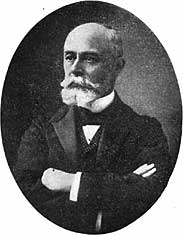![]()
![]()
Were it not for several unexpected discoveries, we still might not be aware of high energy radiation which is nearly always unnoticed by our senses. As the 19th Century drew to a close, many investigators were studying the behavior of electric sparks passing through glass tubes from which air had been removed. It had been found that some substances would glow when struck by such sparks.
November 8, 1895 Wilhelm Konrad Röntgen (1845-1923) noticed that outside but near such apparatus (up to 2 m away) a scrap of paper coated with one of these substances, barium platinocyanide, lit up with brilliant fluorescence. This seemed strange because it was already well established that the electric current couldn't pass through insulators such as glass and, at this voltage, only short distances through ordinary air. This made it impossible for the electricity to itself travel the distance required to cause this glow. Röntgen realized the unexpected glow must be due to a much more penetrating unknown radiation which he therefore called X-rays.. Within the next few days Röntgen determined the properties of the X-rays (read more detail), identified them to be a form of electromagnetic radiation, then mailed his findings to other scientists on New Year's Day 1896. (A translation of Röntgen's original German publication is among Carmen Guinta's classic papers.)
Three weeks after Röntgen announced his discovery, Antoine Henri Becquerel (1852-1908, shown at right) heard Henri Poincaré report to the French Academy of Science in Paris. Poincaré described the discovery that incident X-rays can cause fluorescence and showed photographs that Röntgen had taken with X-rays. Poincaré wondered if X-rays were emitted by other luminescent bodies. The next day Becquerel began to investigate the connection between X-rays and phosphorescence. (We now know that for many phenomena the conservation of energy allows the time reversal of the process to also occur. But the concept of conservation of energy was relatively new. Poincaré and Becquerel may have been motivated more by a hunch of further connections
rather than wondering whether a reverse process causes phosphorescing minerals to release X-rays.) After several weeks with initial negative results with other materials, Becquerel attempted to determine if Uranium compounds might emit X-rays while sunlight caused them to luminesce (with <1/100th second delay). (read more detail) Becquerel hoped to detect X-rays using Röntgen's technique with photographic plates covered with black paper. The paper would block exposure by sunlight but not stop exposure by the more penetrating X-rays. Rain clouds scattered the sunlight needed to cause the phosphorescence, resulting in Becquerel leaving the covered photographic plates with a mineral called Pitchblende on top, in a dark drawer ready to resume the experiment when the sun returned. When poor weather continued several days and Becquerel felt a need for preliminary results, he developed the photographic plates anticipating very little if any exposure. Instead he discovered that the Pitchblende had emitted penetrating radiation similar to X-rays which greatly exposed the photographic plates. Becquerel noted that the exposure could not be attributed to the luminous radiation emitted by the very brief phosphorescence. Becquerel was cautious to avoid claiming that this radiation was actually X-rays. It was clear that Pitchblende emits radiation even without being energized by the sunlight necessary to cause luminescence. (Carmen Guinta translates Becquerel's original French papers.)
You could repeat Becquerel's experiment provided you have a radioactive source and photographic film. If you don't have the needed materials the experiment has been repeated many times by the author and his students so that a couple of their photographs can be shared with you.

product: sheet filmon their web site) To allow successive photographs using different kinds of Polaroid film, each light sensitive emulsion is separately wrapped in heavy, light stopping paper.
 Development of photographic image:
Development of photographic image:
developmentof the image. We have developed the emulsion above by manually rolling over the covered film and pouch with a rubber roller.